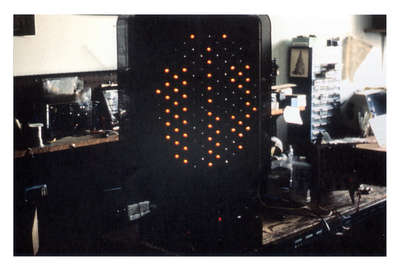When Normen White bought his first computer in 1976, numerous approaches to computer-specific art had already developed all over the world. But nevertheless Norman’s role is particular and stands out within the context of computer-generated art. When he turned to the computer, he had a phase of ”digital“ art behind him already, during which – from 1966 onwards – he had been constructing electrokinetic objects that independently gnerated and varied specific preprogrammed forms and patterns by means of digital switching circuits – a type of function that others were creating by means of computers. In each case, the patterns were visualised in changing sequences of illuminated light bulbs. (Herzogenrath & Lähnemann 2009:7)
This work is the first example of this early works and it is also an example of those works that White intended as an object with a “life of its own” (Herzogenrath & Lähnemann 2009:19)
This first major electronic project was built specifically for the 1969 E.A.T. group exhibition entitled “Some More Beginnings”, in New York City. Using several hundred early-vintage digital integrated circuits donated by the Sprague Electric Company, Norman set about creating a machine which would autonomously generate shimmering light patterns similar to those seen at the bottoms of swimming pools. Much of the ten months spent making the machine involved teaching himself electronics. When it was finally done, the patterns generated turned out to be more reminiscent of clouds swirling past an airplane porthole, or rain dripping down a window-pane. Looking back now, Norman realize it is an early Cellular Automata experiment.
[http://www.normill.ca/artpage.html] (consulted 27.10.08)


